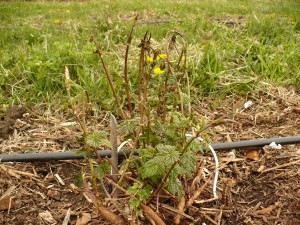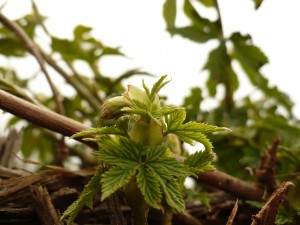Most of Vermont got hit by a pretty hard frost last weekend, and we’ve received numerous calls about what to do about frosted hops. In our two-year-old variety trial, Nugget in particular got a good wallop, whether that was because it isn’t as frost-tolerant as some of the varieties or because it was a little taller then the others is unknown. Things looked pretty grim across the whole yard the morning after the frost, but a few days later, it seems like most of the plants have recovered. For the varieties that were already a couple of feet tall, the frosted tips are looking brown and wilted like over-cooked asparagus.

What to do? Well, the tips of those shoots are good and dead, and they won’t continue to grow up. With the terminal buds dead, some of them are even starting to send out sidearms, which some reports say can take over as the growing point, but with reduced growth and yields as a result. In our hopyard, we’ve clipped back the shoots where the frost has nipped the tip, and the hop crown has already sent out new, undamaged growth.
For those who have a newly-planted hopyard, or have weaker crowns where only one or two shoots have emerged, I would suggest caution in trimming back the hills too much. The hop crown might be too weak to push more growth. By not trimming back the growth that has had its growing point nipped, you might lose your yield, but hopefully you won’t lose the entire hill.
While you are out in the yard, keep a sharp eye out for downy mildew spikes!

This is downy mildew making itself known: note the short internodes with down-curled leaves, particularly in comparison with the longer, leggy growth you see in the picture above. If you see these spikes, get ’em out of your yard! Other than that, we don’t really counsel removing the first flush of growth in the Northeast. In the Pacific Northwest, producers often prune the first growth, but here, our growing season is a bit shorter, and barring new data, we advise against pruning.